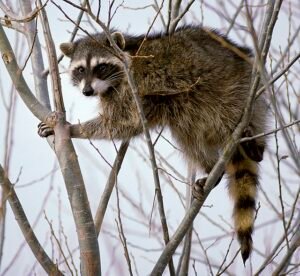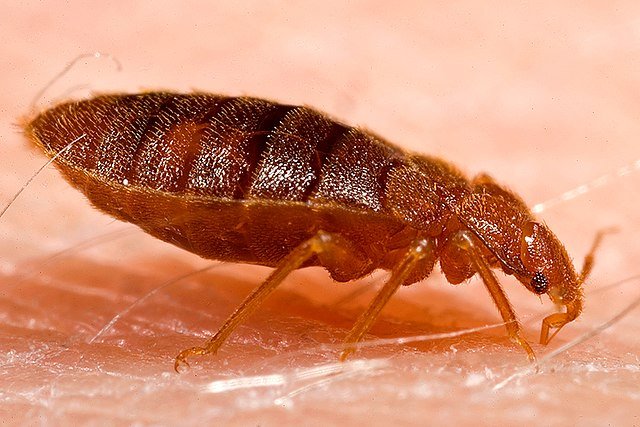Raccoons (Procyon lotor): Urban Tricksters or Dangerous Pests?
 Few animals divide opinions as sharply as the raccoon (Procyon lotor). With its masked face and nimble paws, this medium-sized mammal has become both a cultural icon and a major pest species in many parts of the world. In North America, raccoons are common in both wild habitats and urban neighborhoods, where they rummage through trash cans, raid attics, and cause significant property damage.
Few animals divide opinions as sharply as the raccoon (Procyon lotor). With its masked face and nimble paws, this medium-sized mammal has become both a cultural icon and a major pest species in many parts of the world. In North America, raccoons are common in both wild habitats and urban neighborhoods, where they rummage through trash cans, raid attics, and cause significant property damage.
Unlike Fruit flies (Drosophila spp.) or Blow flies (Calliphoridae), raccoons are not insects but mammals with complex behavior, intelligence, and adaptability. Their problem lies not in sheer numbers but in their ability to exploit human resources—garbage, crops, and even buildings.
This guide explores raccoons in detail: their identification, biology, global spread, risks, signs of infestation, control methods, and cultural importance.
Identification
Scientific name: Procyon lotor.
Size: Adults weigh between 5–15 kg, with a body length of 40–70 cm and a bushy ringed tail of 20–40 cm.
Coloration: Grayish-brown fur with a distinct black “mask” across the eyes.
Features: Highly dexterous front paws, capable of opening latches, containers, and even doors.
Behavioral cues: Nocturnal, often spotted near garbage bins, gardens, or attics.
Field distinction: Raccoons are often confused with opossums (Didelphis virginiana) in urban areas, but opossums lack the distinctive mask and have prehensile tails, unlike raccoons.
Biology and Ecology
Raccoons belong to the family Procyonidae, closely related to coatis and kinkajous.
Diet: Omnivorous. Their food includes fruits, nuts, insects, small vertebrates, bird eggs, crops, and human waste.
Reproduction: Breeding season is typically January to March. Females give birth to 2–5 kits after a gestation of about 63 days.
Lifespan: In the wild, raccoons live 2–3 years on average due to predation and disease, though some survive up to 10 years. In captivity, lifespans can exceed 20 years.
Social structure: Solitary by nature, though females raise offspring together for months. In urban areas, loose groups may share food-rich territories.
Ecological role: Raccoons act as seed dispersers, insect predators, and scavengers. They may feed on Pigeons (Columba livia), small rodents, and agricultural pests, indirectly benefiting ecosystems but creating conflicts with humans.
Global Distribution
Originally native to North America, Procyon lotor has expanded far beyond its natural range:
North America: Abundant across the U.S., Canada, and Mexico. Particularly dense in cities and suburban zones.
Europe: Introduced populations exist in Germany, France, and Eastern Europe, where raccoons thrive as invasive species.
Asia: Established in Japan and parts of Russia after escapes and intentional releases.
Other regions: Rare introductions reported elsewhere, often linked to the exotic pet trade.
This wide spread is a direct result of their adaptability, intelligence, and willingness to exploit human environments.
Risks and Damage
While raccoons are fascinating, they are also problematic. Key risks include:
1. Property Damage
Tearing shingles, siding, or insulation when breaking into attics.
Raiding garbage cans, leaving mess and odor.
Digging lawns for grubs or earthworms.
2. Agricultural Damage
Feeding on corn, grapes, melons, and nuts.
Preying on poultry and eggs, particularly in small-scale farms.
3. Health Concerns
Carriers of rabies—a major zoonotic threat.
Feces may contain Baylisascaris procyonis, a roundworm dangerous to humans and pets.
Possible vectors for leptospirosis, salmonella, and canine distemper virus.
4. Ecological Impact
Competition with native predators.
Predation on songbird nests and amphibians, especially in regions where they are invasive.
Signs of Infestation
Homeowners and property managers can detect raccoon presence through:
Tracks: Distinct five-toed paw prints resembling tiny human hands.
Scat: Tubular droppings, often found near dens.
Noise: Scratching, thumping, or chattering in attics at night.
Structural damage: Torn soffits, insulation displacement, or overturned garbage cans.
Odor: Strong musky smell from urine and feces.
Control Methods
Basic Prevention
Secure garbage cans with raccoon-proof lids.
Remove outdoor pet food at night.
Install fencing around gardens and chicken coops.
Seal entry points into attics, chimneys, and crawl spaces.
Exclusion and Deterrence
One-way exclusion doors allow raccoons to exit but not re-enter.
Motion-activated lights or sprinklers deter nocturnal visits.
Strong fencing buried at least 30 cm underground prevents digging.
Trapping and Removal
Live traps are commonly used but must comply with local wildlife regulations.
Relocation may not always be legal or effective.
Professional pest control is recommended, particularly when rabies risk is high.
Advanced Approaches
Integrated Pest Management (IPM) can be adapted for raccoons:
Habitat modification: Reduce food availability, maintain secure compost bins, and manage bird feeders to avoid attracting raccoons.
Biological control: Natural predators such as coyotes, bobcats, and owls may help in rural areas but are impractical in cities.
Technology: Modern repellents, ultrasonic devices, and smart surveillance systems provide additional tools.
Public education is crucial. Many urban raccoon problems stem from intentional feeding by humans, which habituates them to human contact.
Cultural and Historical Context
Raccoons hold a unique place in human culture:
Native American traditions: Often portrayed as trickster figures, symbolizing cleverness and adaptability.
Fur trade: Raccoon pelts were once highly valued in North America, contributing to their widespread hunting.
Pop culture: Characters like “Rocket Raccoon” from Marvel or “Meeko” from Disney’s Pocahontas have cemented raccoons as mischievous yet endearing animals.
Urban folklore: Stories of raccoons opening coolers, unlocking cages, or washing food have spread widely, further emphasizing their intelligence.
FAQ
Q1: Are raccoons dangerous to humans?
Yes, mainly because of rabies and roundworm risks, not because of aggression.
Q2: Can raccoons be kept as pets?
Illegal in many regions. Even where legal, they are high-maintenance, destructive, and risky for disease transmission.
Q3: Do raccoons really wash their food?
In captivity, raccoons often dunk food in water, but this behavior is linked to tactile exploration rather than hygiene.
Q4: What attracts raccoons to urban areas?
Trash, pet food, bird feeders, and easy shelter such as attics or sheds.
Q5: How can farmers protect crops from raccoons?
Electric fencing, guard animals, and motion-based deterrents help reduce crop raids.
Q6: What role do raccoons play in ecosystems?
They disperse seeds, control insects, and scavenge carrion, but can become ecological threats in non-native regions.
Final Thoughts
Raccoons (Procyon lotor) represent the perfect paradox of modern wildlife: intelligent, adaptable, and even charming, yet capable of causing significant economic, health, and structural damage. Their masked appearance makes them one of the most recognizable animals in urban and rural North America, but also one of the most controversial.
Unlike pests such as Fruit flies (Drosophila spp.) or Blow flies (Calliphoridae), raccoons cannot be eliminated with traps and sprays alone. They require a strategic approach combining exclusion, habitat modification, and education. Human behavior—particularly leaving out trash and food—often fuels raccoon problems. Managing these animals successfully means not just controlling them but also modifying our practices.
As invasive populations expand in Europe and Asia, raccoons serve as a reminder that wildlife can adapt quickly to human-altered landscapes. Their resilience ensures they will remain both admired and feared for generations to come.
Disclaimer
This article is for informational purposes only. Pest control laws and approved methods vary by country. For best results and legal safety, we strongly recommend contacting a licensed pest control professional in your local area. Always make sure that the pest control technician is properly certified or licensed, depending on your country’s regulations. It’s important to confirm that they only use approved products and apply them exactly as instructed on the label. In most places in Europe, the UK, or the USA, following label directions is not just best practice—it’s the law.
Author
Nasos Iliopoulos
MSc Agronomist & Certified Pest Control Expert
Scientific Director – Advance Services (Athens, Greece)
Licensed Pest Control Business – Ministry of Rural Development & Food (GR)

